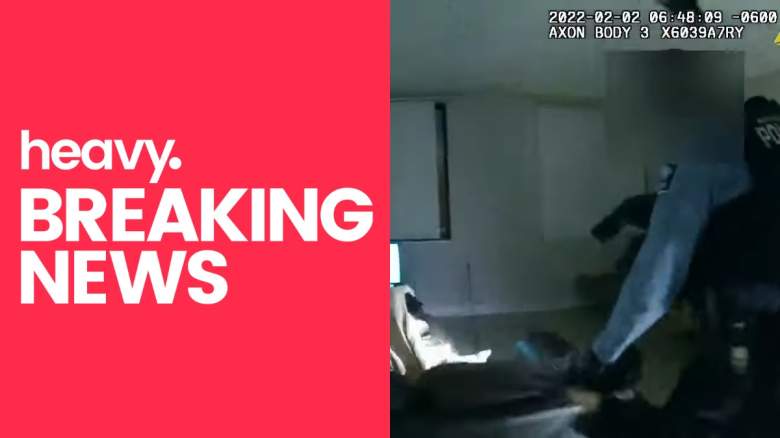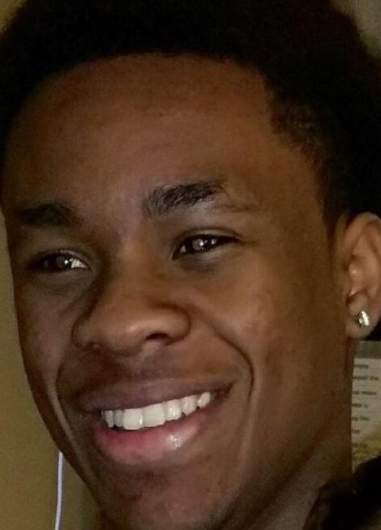
Mark Hanneman is the Minneapolis Police officer who killed Amir Locke in a shooting on February 2, 2022, in the Minnesota city. Hanneman shot Locke 3 times 9 seconds after entering the apartment where he was sleeping. Hanneman and other officers were serving a search warrant about 6:48 a.m. The 22-year-old Locke was not the target of the warrant, according to his family and the Minneapolis Star-Tribune.
Body camera video was released of the shooting on Thursday, February 3, 2022. Police said in a press release that Locke reached for a handgun before he was shot. Locke’s family has said he legally owned the gun. Locke, who is Black, had no criminal history, his family said. They are being represented by prominent civil rights attorney Benjamin Crump, who has been the lawyer for the families of George Floyd and Daunte Wright in recent Minnesota cases that led to criminal convictions of police officers and multi-million lawsuit settlements.
The shooting is being investigated by the Minnesota Bureau of Criminal Apprehension. Hanneman, 34, who has not commented about the fatal shooting, has been placed on paid administrative leave by the Minneapolis Police Department. Interim Chief Amelia Huffman said in a press release she has reviewed the video footage and her department is cooperating with the independent investigation.
Here’s what you need to know about Minneapolis Police Officer Mark Hanneman and the deadly shooting:
1. The Body Camera Video Shows an Officer Kicking the Couch Where Amir Locke Was Sleeping to Wake Him Up Before He Was Shot by Mark Hanneman
The city of Minneapolis released 54 seconds of body cam footage showing Officer Mark Hanneman fatally shooting Amir Locke during the February 2, 2022, raid. The video, posted to YouTube by the city, first shows a slowed-down version of the incident. The full-speed version of the officer’s BWC video starts at the 40-second mark of the video and lasts 19 seconds. The officers, including Hanneman were serving a search warrant connected to a St. Paul homicide, the Star Tribune reports. But Amir Rahkare Locke was not a target of the warrant, according to the newspaper and Ben Crump, the attorney who is representing Locke’s family.
The video shows an unnamed officer, whose body cam video was released, inserting a key into the door of the apartment. He then opens the door and other officers enter, yelling, “police search warrant.” The officers flood into the apartment while continuing to yell commands, including, “hands,” and “get on the ground.” Locke can be seen sleeping on a couch that is facing away from the door and the officers. He is under blankets when the officers enter.
The video shows one of the officers kicking the couch, which wakes Locke up. An officer screams at him, “Get on the f***** ground,” Locke reaches for a gun that was on another piece of furniture in front of the couch. Hanneman then opens fire, shooting Locke three times as the video ends. He was the only officer to fire his gun.

Family PhotoAmir Locke.
Locke’s family, including his parents, Andre and Karen Locke, viewed the video before it was released to the public, the Star Tribune reports. Crump said in a statement, “Like the case of Breonna Taylor, the tragic killing of Amir Locke shows a pattern of no-knock warrants having deadly consequences for Black Americans. This is yet another example of why we need to put an end to these kinds of search warrants so that one day, Black Americans will be able to sleep safely in their beds at night.”
Crump’s law firm said in a press release, “Locke, who has several family members in law enforcement and no past criminal history, legally possessed a firearm at the time of his death.” Minnesota-based Attorney Jeff Storms, who is working on the case with Crump, added in a statement, “In the wake of George Floyd and Breonna Taylor, the city of Minneapolis told the public that it was limiting the use of no-knock warrants to ‘limit the likelihood of bad outcomes’ Less than two years later, Amir Locke and his family needlessly suffered the worst possible outcome. Our city has to do better.”
In a press release, the Minneapolis Police said they were executing a warrant at an apartment building in the 1100 block of Marquette Avenue South for the Saint Paul Police Department Homicide Unit when Locke was shot and killed. Locke was in a seventh-floor apartment unit. The press release said, “officers encountered a male who was armed with a handgun pointed in the direction of officers.”
After Locke was shot, the officers “immediately provided emergency aid” and “carried” him down to the lobby to meet paramdeics, the press release said. The press release names him as a suspect even though he wasn’t a target of the early morning raid. Locke was taken to a local hospital where he was pronounced dead, police said. Locke was shot twice in the chest and once in the wrist, according to documents released by the city.
2. Hanneman Has Been a Minneapolis Police Officer Since 2015 & He Is a Member of the Department’s SWAT Team
According to his personnel file, which was released by the city, Mark Thomas Hanneman was hired by the Minneapolis Police Department in 2015. He is a member of the department’s SWAT team.
During his time with the Minneapolis police, Hanneman, badge #2654, has been the subject of three complaints, but all were closed with no discipline, according to a document released by the city. The document does not provide any other details about the employee complaints. A fourth complaint, filed against him in 2018, remains open, according to data from Communities Against Police Brutality.
It was not immediately clear if Hanneman has hired an attorney who could speak on his behalf. The Minneapolis police union has not commented about the shooting. Hanneman could not be reached for comment by Heavy. The 34-year-old is married and lives with his wife and two kids in Hutchinson, according to public records.
Minneapolis Mayor Jacob Frey said at a press conference on February 3 after the body camera video was released that the footage was not immediately released so the family could see it first and so Hanneman could make a statement without seeing the video first. Frey said the city changed its policies in 2021 to make it so officers could not view any video of an incident before making a statement.
Frey said, “This video raises about as many questions as it does answers. And those answers we need to be providing as quickly as possible through a number of investigations that are in fact already underway. Whether through the Bureau of Criminal Apprehension or the Saint Paul or Minneapolis police departments, we intend to get answers as quickly in possible and in transparent fashion, recognizing that as of tonight not all of those answers can be provided. These issues are complex and I know there are so many here who are grieving and don’t care as much about the complexity because a man has lost his life. But it is my job, it is our job, as a leader to figure it out. I do not want to put our public or our officers in harms way. … Truth and justice must be our guiding principles and make no mistake that they will be.”
Huffman, the interim police chief, added at the press conference, “These events unfold in seconds but the trauma is long-lasting. A young man lost his life and his friends and family are in mourning. Community members are in pain and have questions and rightfully so. And the course of the lives of our officers has been changed forever. It’s a sobering moment.”
3. Hanneman Was Previously a Police Officer in His Hometown of Hutchinson, Minnesota, From 2010 Until He Was Hired in Minneapolis
Hanneman is from Hutchinson, Minnesota, located in McLeod County, about 60 miles west of Minneapolis. He was an officer with the Hutchinson Police Department from 2010 until 2015, according to his Minneapolis personnel file. He was also a student officer with the South Dakota State University Police Department from 2006 to 2008 and worked for the park patrol in Hutchinson from May 2007 to August 2007.
Before he was an officer in his hometown, Hanneman worked there from 2008 to 2010 as a communications specialist, also known as a dispatcher, for the city and its police department. In his personnel file, Hanneman wrote about his time in Hutchinson, “I enforce the laws of the state of Minnesota as well as the ordinances of the city. I respond to calls for service and use my skills to assist and to protect the citizens of the city in any way I can. Additionally I proactively patrol the city and take action whenever I can to make the city a better place.”
Hanneman was also a member of the Hutchinson Police Department’s Special Response (SWAT team), according to his personnel file. He said he is “certified as a basic operator and my primary role on the team is entry. I have attended a ballistic shield course and have deployed with a shield in team’s operations.”
4. Hanneman Graduated From South Dakota State University in 2008 & Also Studied at Alexandria Technical College, the University of Minnesota-Twin Cities & Ridgewater College & Is Getting His Master’s in Criminal Justice Leadership
Hanneman graduated from Hutchinson High School in 2005, according to his personnel file. Hanneman then graduated from South Dakota State University in 2008 with a degree in sociology, according to his personnel file. He previously from 2008 to 2009, the University of Minnesota-Twin Cities from September to December 2005 and at Ridgewater College in Hutchinson from 2003 to 2005.
Hutchinson earned a law enforcement certification from Alexandria Technical College in 2009 after a year of taking online classes at the college, which is based in Douglas County, Minnesota, according to his personnel file. Hanneman is also currently pursuing his master’s degree in criminal justice leadership at Concordia University St. Paul. The college published his master’s thesis on police in schools in February 2021. It can be read here.
He wrote in the paper, “Heartfelt thanks to the criminal justice instructors and other staff at Concordia University, St. Paul for their guidance and assistance in completing this program and particularly this capstone paper. Additionally, thank you to Minneapolis Public Schools and the Minneapolis Police Department for affording me perspective and the undeniably unique opportunity to obtain a firsthand view of the struggles and triumphs associated with work as a school resource officer.” Hanneman added, “This capstone is dedicated to my wife and children, for their notable sacrifice in time that could have been spent together. The progression of this capstone paper took place in an unbelievably turbulent period of our lives, and only through their patience and understanding could this task have been completed.”
A photo of a certificate included in his personnel file shows the Alexandria Technical College program was known as Law Enforcement Skills. He also completed a continuing education program through New Mexico Tech in 2009 called “Incident Response to Terrorist Bombings Awareness Level Training Course,” according to his personnel file.
Hanneman also said in his personnel file that he volunteers at a local music festival in Hutchinson, called Riversong, and has done so since 2011. He helps set up sound, lighting and staging at the festival, according to the document. It was not immediately clear if he is still affiliated with the music festival.
5. Hanneman Was Disciplined for Providing Drugs to Occupy Minnesota Protesters in 2012 During a Training Exercise While He Was a Hutchinson Cop & Was Found at Fault in a 2014 Civil Rights Lawsuit Stemming From a Botched Vehicle Seizure
Hanneman was one of two Hutchinson police officers disciplined in 2013 after he provided marijuana to protesters with the Occupy Minnesota movement during Drug Recognition Evaluator training program in the Twin Cities in 2012, according to the Hutchinson Leader. Prosecutors decided there was no evidence to charge Hanneman and the other officer, Karl Willers, according to the newspaper.
The newspaper wrote, “The allegations surfaced after Occupy Minnesota protesters posted a YouTube video purporting to show police giving protesters drugs as part of the drug evaluation training program. Occupy Minnesota was a movement of mostly young people protesting as part of the national Occupy Wall Street movement that swept the country in early 2012.”
Hanneman was named in a 2013 federal lawsuit filed by six Occupy Minnesota protesters who said they were given marijuana as part of the program, which was intended to allow officers to observe behavior by members of the public while under the influence of drugs, according to court documents. He was dismissed from the lawsuit in 2014.
It was not immediately clear if Hanneman had any other disciplinary issues while he was working as a police officer in Hutchinson. City officials in Hutchinson have not commented about the incident and his past history in the city. Hanneman was named in a second federal civil rights lawsuit, filed in 2014, by Travis Coon against Hutchinson officers and McLeod County Sheriff’s Office deputies, according to court documents obtained by Heavy.
In the lawsuit, available here, Coon accuses Hanneman and the other officers of violating his civil rights during a December 2013 incident. Coon was stopped by McLeod County Deputy Billy Kroll in December 2013 after he exited a car with a friend outside of his friend’s house, according to court documents. Hanneman was called to the scene to conduct field sobriety and drug recognition tests, according to the lawsuit. Coon said in the lawsuit he was respectful toward Hanneman and passed all tests. No contraband was found during the search, Coon said in the lawsuit.
Hanneman also searched Coon and confiscated his car keys from his pocket before putting him in a squad car for almost two hours, according to the lawsuit. Coon said Hanneman then opened the door to the police vehicle and told him to “Get the f*** out of here,” and did not listen when Coon asked him to return the keys he had confiscated, according to the lawsuit. Hutchinson Police did not arrest Coon or file any charges, but did impound his car and began forfeiture proceedings against the vehicle and $427 in cash found inside, according to the lawsuit. Coon challenged the forfeiture, but he said in the lawsuit that the police told the bank that financed his car loan that he wasn’t challenging the forfeiture and the bank seized and sold the car.
U.S. District Court Judge Richard H. Kyle ruled in Coon’s favor in 2015, ordering McLeod County and Kroll to pay him $1,000 and Hanneman, the city of Hutchinson and three other officers to pay him a total of $4,500, according to court documents.
